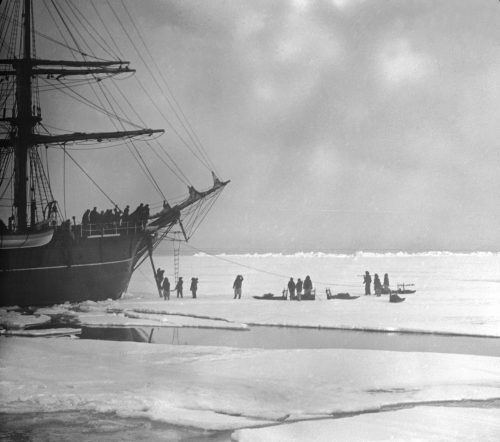Arctic Bound
An exhibition of photographs by Alexander Rodger and David Dickson, 1894-7

Eskimos Going Aboard the Eclipse
by David Dickson, 1894
(Courtesy of Dundee Art Galleries and Museums)
2 October 2012 - 10 January 2013
Discovery Point, Dundee
Mon-Sat 10am-5pm Sun 11am-5pm
Closed 25-26 December and 1-2 January
26 November 2011 - 26 January 2012
Tower Foyer Gallery, University of Dundee
Mon-Fri 09.30-20.30 Sat 09.30-16.30
(closed for Christmas vacation 23 Dec - 3 Jan)
17 June - 30 September 2011
School of Art History Reception, 79 North Street, University of St Andrews
Mon-Fri 09.00-16.45
In the 1890s two young naturalists were sent on expeditions to the Arctic to collect specimens for the Zoology Museum of Professor D'Arcy Thompson at University College, Dundee. They also took photographic equipment with them and captured some fascinating shots of life among the whalers and the native people of some of the northernmost settlements on Earth.
Drawn from three separate collections, these photographs have never before been exhibited together. The exhibition has been created by the University of Dundee Museum Services in partnership with the University of St Andrews School of Art History, the University of St Andrews Library Special Collections, Dundee Art Galleries and Museums and Perth Museum and Art Gallery, and was originally designed to accompany the Polar Visual Culture conference at the University of St Andrews.
Whaling in Dundee
For much of the 19th century, Dundee was the European capital of the whaling industry, bringing in up to 150,000 pounds a year. As many as 15 ships sailed from Dundee to the Arctic at the beginning of every year, returning home in the autumn with whale oil (used in lighting and in processing jute), whalebone (for ladies' corsets) and sealskins (for gloves and hats). By the time the photos in this exhibition were taken, whaling was already in decline, and the last Dundee whaler sailed in 1914.
D'Arcy Thompson's Zoology Museum
D'Arcy Wentworth Thompson was Dundee's first Professor of Biology. Arriving in 1885, he soon built up a large museum for teaching and research. Recognising the potential for acquiring unique collections of Arctic zoology, he sent his assistant Alexander Rodger and one of his students David Dickson on three separate whaling voyages in 1892 and 1894. They brought back numerous specimens as well as the photographs seen in this exhibition.
Alexander Masterton Rodger (1868-1914)
Alexander (or Aleck) Rodger was an apprentice plumber when he began taking evening classes under D'Arcy Thompson. In 1886 D'Arcy took him on as Museum Assistant, which included mounting and labelling specimens. In 1892 Rodger travelled on the whaling ship Esquimaux to collect specimens, with such success that two years later he was sent on another expedition, this time with the Active, travelling to the Greenland Seas. Unfortunately the voyage was marred by terrible weather, the captain fell ill and the ship returned earlier than planned.
In 1895 Rodger became the first professional curator of the Perthshire Natural History Museum (which later became Perth Museum and Art Gallery). He used his Dundee contacts to acquire various Arctic specimens for the museum, and was responsible for a major re-display of the growing collections.
In 1897, D'Arcy asked Rodger to accompany him on his second Bering Sea expedition as official photographer. It was his last epic voyage, and he remained in Perth until his early death in 1914.

Captain Robertson on the Active by A M Rodger, 1894
(Courtesy of Dundee Art Galleries and Museums)
David Elliot Dickson (1874-1940)
David Dickson was born in Blairgowrie in 1874, attended Harris Academy in Dundee and studied Chemistry, Zoology, Anatomy and Physiology in Dundee and St Andrews. It was while studying under D'Arcy that he volunteered to accompany one of the whaling voyages in 1894. His journey (probably on the Eclipse), took him to the Davis Strait between northern Canada and Greenland. He took photos of three whalers, the Eclipse, the Balaena and the Terra Nova, recording the whaling process and also encounters with the native Inuit people.
Dickson later took a medical degree at Edinburgh, where he became a fellow of the Royal College of Surgeons. He spent most of his career working as a doctor in the mining community of Lochgelly, but was also an active member of the British Medical Association. He also served as a medical officer for the Black Watch.

Fur Seal breeding colony on Copper Island by A M Rodger, 1897
(Courtesy of University of St Andrews Library)
The Bering Sea Expeditions
In 1896 and again in 1897, D'Arcy Thompson went on his own expeditions to the far north as part of an international inquiry into the fur seal industry. Russia, Canada and the USA had long hunted fur seals in the open waters of the Bering Sea, but the discovery of the seals' main breeding grounds allowed them to kill seals in vastly greater numbers. Due partly to the fame of his Arctic collections, D'Arcy was asked by the Prime Minister to represent Britain in an expedition to assess the fur seal's declining numbers. In 1896 he travelled to the American-owned Pribilof Islands and the Russian-owned Commander Islands to visit the fur seal breeding colonies.
In 1897 D'Arcy returned to the islands to acquire comparative statistics, and this time took Alexander Rodger with him as official photographer. After three months they returned to Washington to present their findings. D'Arcy spoke for three hours and it is said that his diplomacy was crucial in securing the joint statement which was presented in January 1898, claiming that if the fur seal was protected on land, its numbers would be sustainable. D'Arcy also drew attention to the threat to whales and sea otters, which were being hunted in the same area.
Find out more about the D'Arcy Thompson Zoology Museum